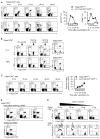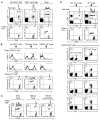Reprogrammed foxp3(+) regulatory T cells provide essential help to support cross-presentation and CD8(+) T cell priming in naive mice
- PMID: 21145762
- PMCID: PMC3032429
- DOI: 10.1016/j.immuni.2010.11.022
Reprogrammed foxp3(+) regulatory T cells provide essential help to support cross-presentation and CD8(+) T cell priming in naive mice
Abstract
Foxp3(+) regulatory T (Treg) cells can undergo reprogramming into a phenotype expressing proinflammatory cytokines. However, the biologic significance of this conversion remains unclear. We show that large numbers of Treg cells undergo rapid reprogramming into activated T helper cells after vaccination with antigen plus Toll-like receptor 9 (TLR-9) ligand. Helper activity from converted Treg cells proved essential during initial priming of CD8(+) T cells to a new cross-presented antigen. Help from Treg cells was dependent on CD40L, and (unlike help from conventional non-Treg CD4(+) cells) did not require preactivation or prior exposure to antigen. In hosts with established tumors, Treg cell reprogramming was suppressed by tumor-induced indoleamine 2,3-dioxygenase (IDO) and vaccination failed because of lack of help. Treg cell reprogramming, vaccine efficacy, and antitumor CD8(+) T cell responses were restored by pharmacologic inhibition of IDO. Reprogrammed Treg cells can thus participate as previously unrecognized drivers of certain early CD8(+) T cell responses.
Figures






Comment in
-
Treg's alter ego: an accessory in tumor killing.Immunity. 2010 Dec 14;33(6):838-40. doi: 10.1016/j.immuni.2010.12.005. Immunity. 2010. PMID: 21168775 No abstract available.
-
Cancer vaccination reprograms regulatory T cells into helper CD4 T cells to promote antitumor CD8 T-cell responses.Immunotherapy. 2011 May;3(5):601-4. doi: 10.2217/imt.11.22. Immunotherapy. 2011. PMID: 21554089
References
-
- Antony PA, Piccirillo CA, Akpinarli A, Finkelstein SE, Speiss PJ, Surman DR, Palmer DC, Chan CC, Klebanoff CA, Overwijk WW, et al. CD8+ T cell immunity against a tumor/self-antigen is augmented by CD4+ T helper cells and hindered by naturally occurring T regulatory cells. J Immunol. 2005;174:2591–2601. - PMC - PubMed
-
- Bennett SR, Carbone FR, Karamalis F, Flavell RA, Miller JF, Heath WR. Help for cytotoxic-T-cell responses is mediated by CD40 signalling. Nature. 1998;393:478–480. - PubMed
-
- Duarte JH, Zelenay S, Bergman ML, Martins AC, Demengeot J. Natural Treg cells spontaneously differentiate into pathogenic helper cells in lymphopenic conditions. Eur J Immunol. 2009;39:948–955. - PubMed
Publication types
MeSH terms
Substances
Grants and funding
- CA096651/CA/NCI NIH HHS/United States
- R01 CA103320/CA/NCI NIH HHS/United States
- R01 CA096651/CA/NCI NIH HHS/United States
- AI063402/AI/NIAID NIH HHS/United States
- CA103320/CA/NCI NIH HHS/United States
- HD41187/HD/NICHD NIH HHS/United States
- R01 HL056067/HL/NHLBI NIH HHS/United States
- P01 CA142106/CA/NCI NIH HHS/United States
- CA112431/CA/NCI NIH HHS/United States
- R01 HD041187/HD/NICHD NIH HHS/United States
- U01 AI083005/AI/NIAID NIH HHS/United States
- R01 AI063402/AI/NIAID NIH HHS/United States
- R01 CA112431/CA/NCI NIH HHS/United States
LinkOut - more resources
Full Text Sources
Other Literature Sources
Molecular Biology Databases
Research Materials

